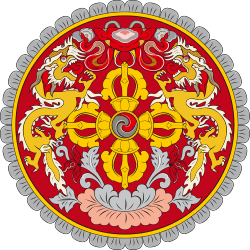Agriculture in Bhutan

Agriculture in Bhutan has a dominant role in the Bhutan's economy. In 2000, agriculture accounted for 35.9% of GDP of the nation.[1] The share of the agricultural sector in GDP declined from approximately 55% in 1985 to 33% in 2003. Despite this, agriculture remains the primary source of livelihood for the majority of the population.[2]
Approximately 80% of the population of Bhutan are involved in agriculture.[3] Over 95% of the earning women in the country work in the agricultural sector.[4] Majority of the refugees in this Himalayan nation are also employed in the agricultural sector.[5] Agriculture in Bhutan is characterized by its labor-intensive nature with relatively low intensity of farm inputs. Most of the peasants in the country are small and marginal.[2]
Among the agricultural lands in the nation, an estimated 21% are wetland (irrigated), approximately 43% are dryland (rainfed), nearly 27% are used for shifting cultivation, approximately 3% are used for orchards and 1% are kitchen gardens.[2]
Major crops cultivated in Bhutan are maize and rice. Maize accounts for 49% of total domestic cereal cultivation, and rice accounts for 43%. Rice is the major staple crop. Agriculture in the country includes cultivation of wheat and other minor cereal crops.[1] Paddy is the primary crop in those regions where proper irrigation is available. Apart from paddy, other crops like wheat, barley, oil seeds, potato and different vegetables are also cultivated in these lands. Maize is mainly cultivated in dryland regions at lower elevation.[6] Forests in the nation act as the source of livestock fodder and organic materials for the purpose of development of fertility. Forests are also responsible for regulating the availability of water for agricultural purpose.[7]
The primary goals of agriculture in Bhutan are to raise the per capita income of the people living in rural areas, to enhance self-sufficiency in staple crops, and to increase the productivity per unit of farm labor and agricultural land. Agriculture is hampered due to irrigation problem,[6] rough terrain, poor soil quality and limited number of arable lands.[3] But several other factors have contributed in the development of agriculture. These factors include improved quality of various cereal seeds, oil seeds, and vegetable seeds, use of fertilizers, mechanization process and trained agricultural experts.[6] The agricultural sector have experienced development especially in the following projects:
- Paro Valley Development Project
- Geylegphug Development Project
- Punakha-Wangdi Valley Development Project
- Tashigang-Mongar Area Development Project
- Chirang Hill Irrigation Development Project.[6]
Production of cash crops such as apple, orange and cardamom have increased and have become profitable. In several areas the shifting cultivation is being replaced by the orchard cultivation. Academics expect this will increase the cultivation of cash crops.[6]
In 2013 the government announced that Bhutan will become the first country in the world with 100 percent organic farming[8] and started a program for qualification. This program is being supported by the International Federation of Organic Agriculture Movements (IFOAM).[9]
See also
References
- 1 2 Suresh Chandra Babu, Ashok Gulati (2005). Economic Reforms And Food Security: The Impact Of Trade And Technology in South Asia. Haworth Press. p. 329. ISBN 1-56022-257-3.
- 1 2 3 Small Farmers and the Food System in Bhutan
- 1 2 The DOHA Development Agenda. United Nations Publications. 2004. p. 201. ISBN 92-1-120338-4.
- ↑ Jennifer Kitts, Janet Hatcher Roberts (1996). The Health Gap: Beyond Pregnancy and Reproduction. International Development Research Centre (Canada). p. 97. ISBN 0-88936-772-8.
- ↑ Catherine Mears, Helen Young (1998). Acceptability and Use of Cereal-based Foods in Refugee Camps. Oxfam. p. 49. ISBN 0-85598-402-3.
- 1 2 3 4 5 Ramakant, Ramesh Chandra Misra (1996). Bhutan: Society and Polity. Indus Publishing. p. 149. ISBN 81-7387-044-6.
- ↑ Stephen R. Tyler (2006). Communities, Livelihoods and Natural Resources: Action Research and Policy Change in Asia. International Development Research Centre (Canada). pp. 193–4. ISBN 1-55250-230-9.
- ↑ "Bhutan set to plough lone furrow as world's first wholly organic country". The Guardian online. 11 February 2013. Retrieved 25 January 2013.
- ↑ "Presentation on Science Based High Yielding Organic Agriculture by IFOAM". Bhutan Minister for Agriculture and Forests. 16 December 2013. Retrieved 25 January 2013.
